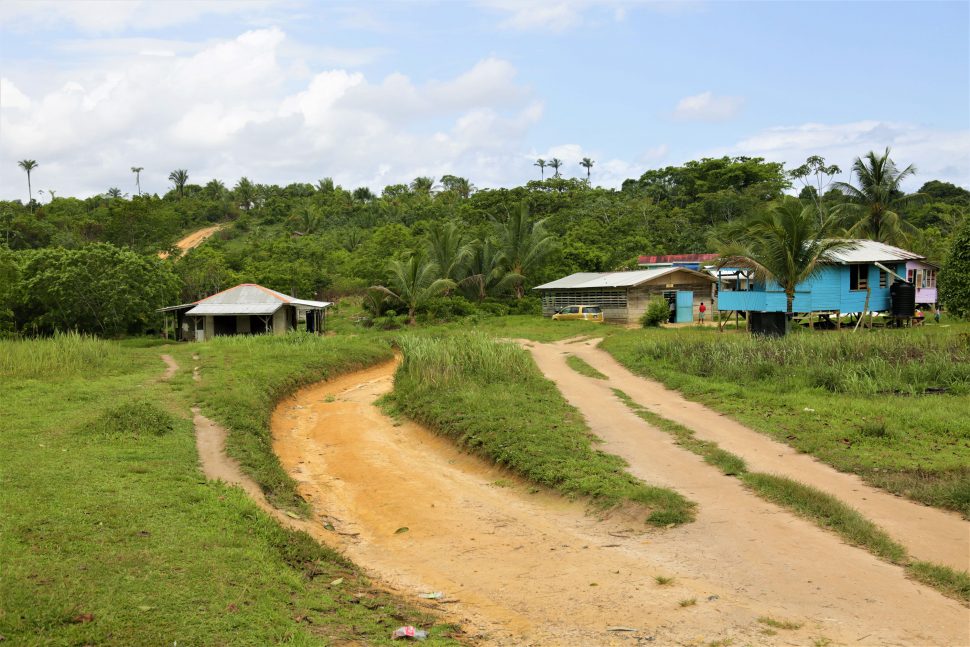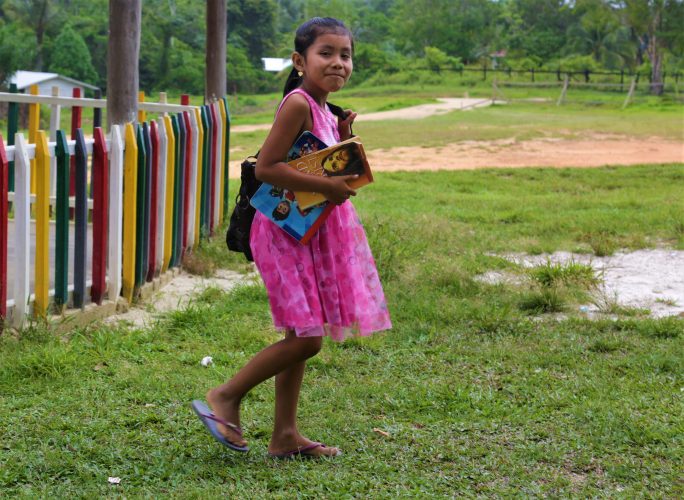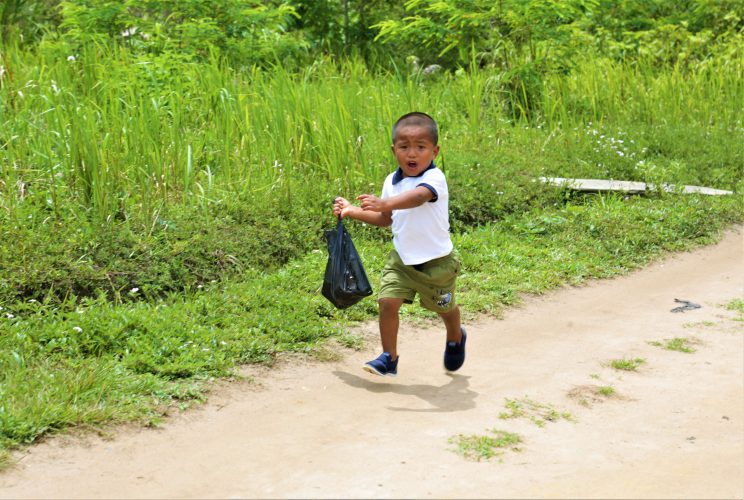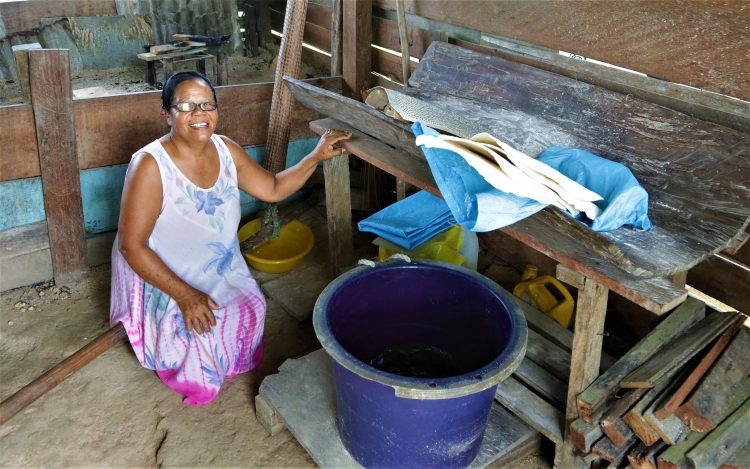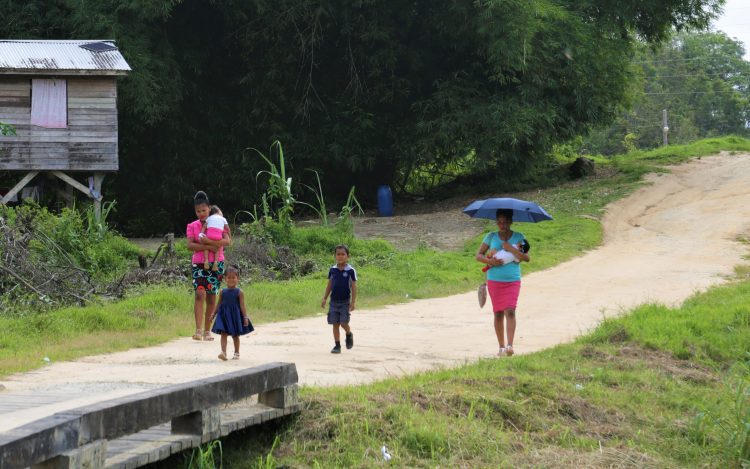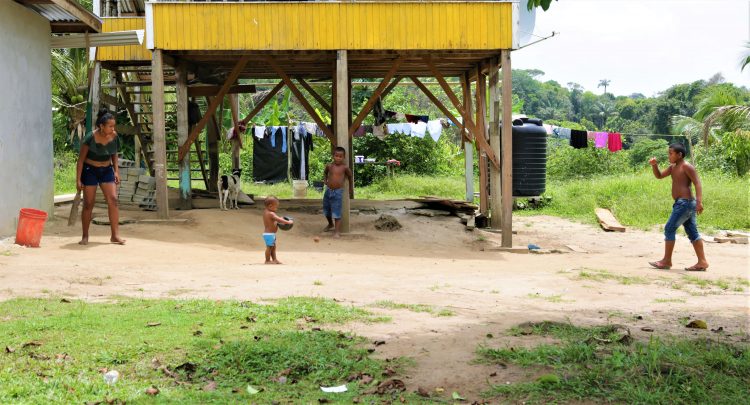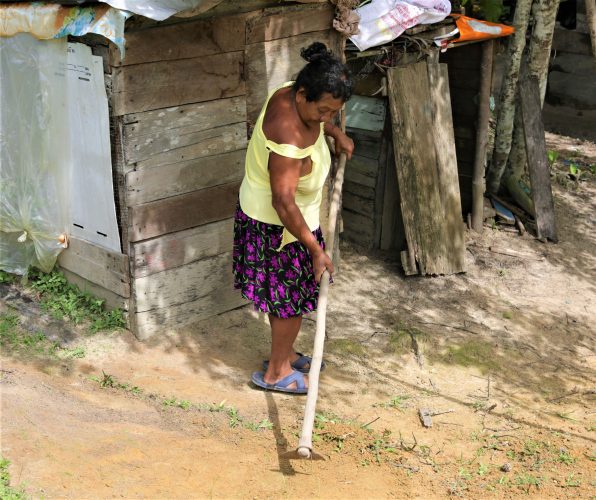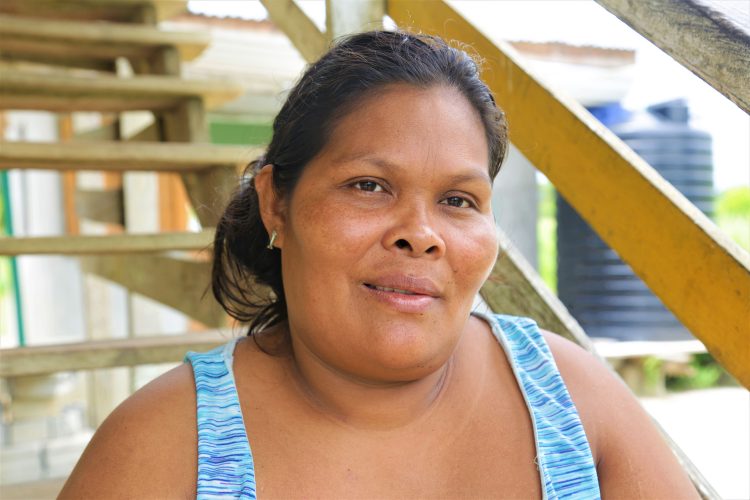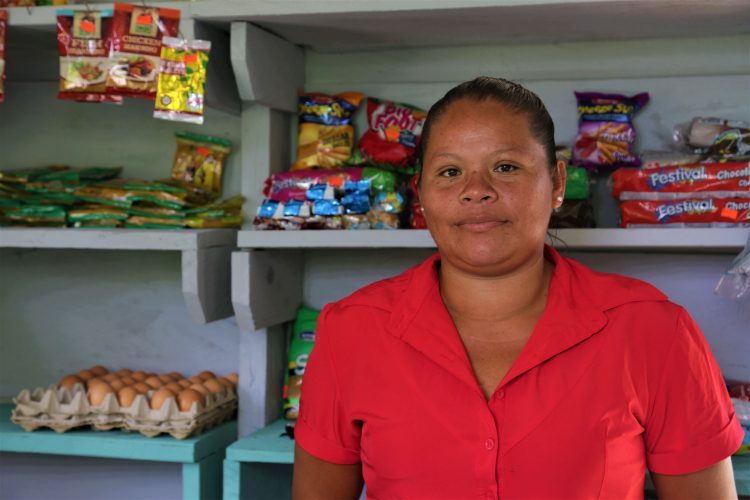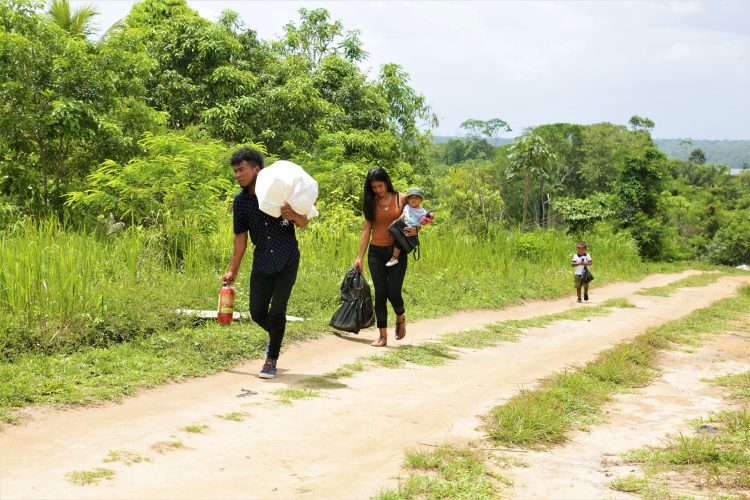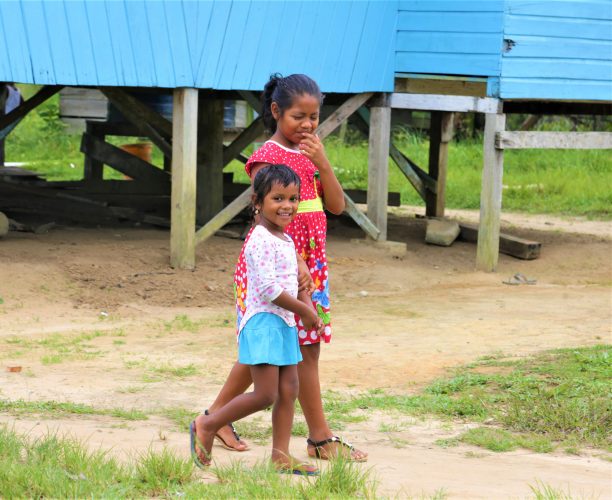Dagg Point is a community in the Cuyuni/Mazaruni region, a few miles outside of Bartica with 360 residents scattered about its hilly, forested terrain. Most of them belong to the Warrau, Carib and Arawak indigenous tribes.
To get to Dagg Point, one must first travel to Bartica and then take a taxi that costs $1,000 to go as far as the beginning of the village and $2,000 – $3,000 to go further in.
The Johns were the first couple to live in Dagg Point some time in 1978. Carlotta John-Hopkinson, now 59 years old, is a daughter of that first family. “I am from a village called Saint Bede’s Mission, Barima/Waini. In Saint Bede’s Mission we had a captain by the name of Amos Joseph. He couldn’t read and write, but you couldn’t mess with him,” John-Hopkinson said. “The captain used to go and represent his people in Georgetown. That time we ain’t know about Georgetown.
“My father was the assistant in the school, he used to carry on the service when was Christmas time, Easter time…. He was originally from Aruka River, Barima/Waini. My mother was from Dutch Guiana. Her mother kidnapped her from her father who she was living with at the time and brought her to Guiana. I never learn why she did that.
“When I was older, at 14, I left Saint Bede’s Mission with an older sister by the name of Muriel John-Jones. I initially had boarded my cousin Sunny Walker’s ship for St Lucia, but my sister didn’t want to go because she had a gentleman in Bartica, so I decided to come with her. I didn’t care where we were going, I was excited for the trip.”
Once in Bartica, she stayed with her sister and her husband-to-be for a little while. At 15, she had her first child and went to live with the child’s father in Second Avenue where she remained for 34 years. By the time she was 28 years old, John-Hopkinson had 12 children; only six are still alive today.
John-Hopkinson moved to Dagg Point on February 26, 2006. For 27 years, she was employed at the National Insurance Scheme. Today she is head councillor of the Dagg Point Council.
The woman shared that at Saint Bede’s Mission her family lived in a six-bedroom house with a troolie-thatched roof. “My father… used to make his own furniture. He was a Jack-of-all-trades. He could make the guitar, the banjo; cook, do catering; if you had a bad tooth, he used his pliers and take it out,” she said. “He could have sewed also. He didn’t send his children to the hospital; he could take care of them good. Daddy was a bad sweet man. He left my mother three times before he went for good. He was well respected though, because of his hard labour. As a father, he was disciplined… oh gracious me… When my father pull up his pants past his waist and you see he haul down that khaki shirt and he chuck it in and draw that skipping rope or the nibbi tight, don’t hang around that man. He’s a terrorist when you see he dress like that; bare feet he used to be…
“The yard had to be spic and span. You cannot, as the girl child, say you going out of the bedroom and your hair ain’t comb. You can’t handle cup and tea; you can’t do food and you ain’t bathe. The boys got to sweep the yard and bust firewood before they go to school. Me, I was lil girl; I dress up in house. We had big sisters to wash for us, press for us, cook our food. I was the third to last. I had nothing to do until we leave by ourselves when daddy and mommy and the bigger ones left for Bartica. That’s when I know about responsibility. At eight years old. I had to run the kitchen. That’s when I learn to grate cassava, digging, grating, matapeing, and cooking and finish to dress myself and the two smaller ones to reach to school for nine. We go to school bare feet, no shoes and socks but we used to wear our uniform, green bottom and white top with we nice ponytail and handbook in we hand, no plastic bag.
“I does tell me grandson y’all got it good. All of us children went to school. My mother never see school door. My father said he went to school for three months in his whole life. If my father had gone to UG…, he might have been the next president cause he was such an intelligent man. He stayed in Orealla with his other family where he died.
“It grieved me to leave Second Ave and come to live in Dagg Point because it made it difficult to get to work… Here was forest when I come here and had just a track to get in and out of the area.” She would start walking out to work and flag down a passing truck or motorcycle and asked for a ride.
“I tell me son only an hour ago that I know about wearing wet uniform to work with old shoes on my foot because y’all got to get milk, y’all got to get soap… and nobody ain’t staying home, all body going to school. It was a sacrifice and I never give up. I work through it. Today all my children can read and write for themselves.”
Today Dagg Point has a high rate of truancy and dropouts. She believes this is because of parental negligence. John-Hopkinson said the community can benefit from a vocational centre, which will not only help the youths to acquire necessary skills but will also aid them in proper socialization and much needed motivation.
The community ground is used every day. Residents of all ages and sexes meet in the afternoons to play cricket. The biggest event in Dagg Point is heritage month when residents prepare various dishes like pepperpot, tuma pot, piwari, fly and cassava bread.
Dagg Point has no potable water or electricity. Its people depend on the rain for water to drink. John-Hopkinson is the only resident who has electricity and she explained that she bought her own poles and cables have it set up.
What the community really needs she said, is a proper road.
A normal day finds John-Hopkinson farming on the hill behind her son’s house. Three of her sons live in the same compound as she does with their families. They have their own houses.
She showed me her two kitchens. In one she cooks in for her family and in the other she does her indigenous work. This latter kitchen is situated behind her house. She keeps two warashis, her grater, matapee and tools she needs to make cassava bread, cassava water and other cassava dishes. Beneath a shelf she pointed out buckets of sugarcane wine left to age for heritage month.
Constituency Nine representative and councillor of Dagg Point, Shellan John, was born in Kwebana, Barima/Waini. She noted that while persons had been residing in Dagg Point for decades, it was opened as a village in 2003. She was a child then and was chosen to cut the ribbon.
John has a generator that provides electricity for her home and shop. Some nights, she said, the family would use $1,000 in fuel.
The woman lamented about the condition of the bridge at the head of the village and even more about the bridge the children attending Three Miles Secondary would take. The villagers had requested assistance from the Bartica Town Council in January, but nothing has been done to date.
“… I remember the village had 28 houses but the last census we did we counted 59 houses with six or eight children in a house. Is only me have three children. From last August when we did the census about eight or nine babies born from that time to now. Only the older persons would know their dialects,” John said.
Both the nursery and primary children attend the school in Agatash, some distance away. For some children, the walk is a 45-minute trek. Some persons send their children to the nursery and primary schools in Bartica. For medical attention, the villagers rely on the health centre in Agatash.
Dagg Point has three churches – the Full Gospel Church, Grace Pentecostal Church and the New Testament Fellowship Church which John attends.
“Dagg Point is a peaceful village. Though we are all family, we keep to ourselves, we have our own houses. Nobody gets into quarrels with each other. We depend on the creek running through the village to do our washing and bathing,” John said. She added that some persons would drink the creek water and fall ill. The creek is not as clean as it used to be. There was once a well in the village that was powered by solar panels, but it was struck by lightning and stopped working.
The people of Dagg Point are into mining and farming. They plant bitter cassava, sweet cassava and other ground provision. John’s husband is a miner. Whenever he is out, he works in construction.
John had done a one-year Hinterland Employment and Youth Service (HEYS) programme on garment construction and worked as a seamstress in the village. However, because the sewing machine used a lot of electricity, it was not feasible. John noted that they were taught to sew on electric rather than pedal machines. When she made uniforms, she charged $3,000 which was costly for persons. Today she only sews uniforms for her daughter.
At the end of the programme, participants were given $50,000 each. John used part of her grant to buy biscuits and confectionary for resale; $15,000 were invested in raw gas to be sold. The remaining money was used up in transportation. In February, when officials from the HEYS programme returned they gave participants another $50,000. Part of the second grant, along with the profit she made from her business, was put into buying materials for her shop, which her husband built by himself. Some of the money also went into expanding her business; she also sells some small groceries items. John intends to have her sewing shop attached to her current shop once the Guyana Power and Light installs electricity.
Josephine Scott was busy weeding her yard with a hoe. She hails from Baramita, Matthew’s Ridge. The 64-year-old woman left her hometown while in her twenties. Back in Baramita, she sold cassava by the bag. Cassava bread, she noted, was sold for 25 cents per cake or bread. Her husband, she said, is related to the John family.
Scott and her husband are farmers. They plant cassava. She loves using the cassava water to make tuma pot. She makes this dish five to six times a month. A pot, once topped up, can last up to three weeks. Scott tops up her pot with fish, chicken, wild hog, labba or bush cow.
Her kitchen is under a shed in the yard. The woman admitted that she loves cooking on the fireside as the food finishes faster. Her husband prefers to cook on their stove in the house.
Living at the side of a slope, Scott said, they would be flooded from time to time. Sometimes she would see a labaria snake around the area. The area is said to have anacondas also.
For grocery shopping, Scott and her family would venture to Bartica.
“I am from a place call Kwebana, Region One,” Royann George said. She lives further into Dagg Point, accessed by a walk up a steep hill, which is backbreaking for anyone unfamiliar with country life; residents do it without even breaking a sweat.
George moved to Dagg Point seven years ago; she lived in Georgetown for two years before moving. Dagg Point, she said, is better compared to the situation in Kwebana as it relates to getting jobs.
The creek the family relies on is situated half a mile away at the bottom of the hill. They bathe and do their laundry at the creek then fetch their heavy buckets of wet clothing back uphill to hang on their clotheslines.
George is a shopkeeper and sells dry goods. The woman said that when her children started going to nursery school, she would carry them out and stay at the school instead of having to walk the hills four times. The distance to the nursery school used to have her little ones crying and begging not to have to go to school but they have since grown used to it.
Taxis, George further said, would only bring commuters in if the road is dry. If it is raining, persons are left to walk from the head of the village even if they have heavy bags of goods. She is pleading for the road to be fixed soon and the talks of constructing nursery and primary schools in the village bear fruit.
